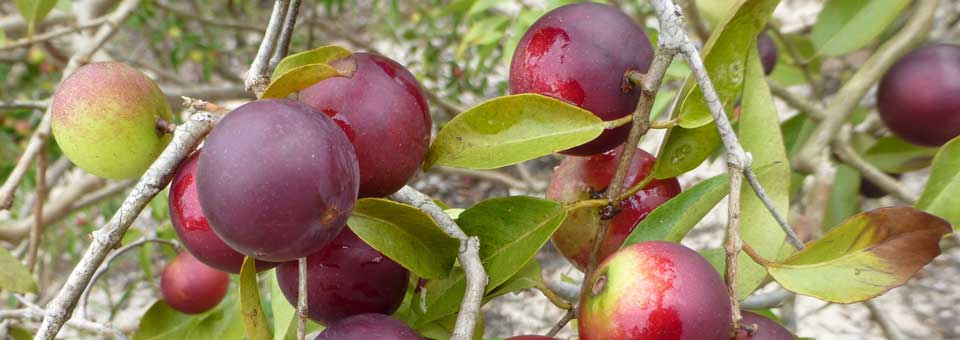
When I visited the Ashaninka Indians in Peru, I noticed they would pick berries from shrubs that grew along the flooded banks of the Amazon and use them as fish bait.
Once they’d caught their dinner, they’d gather more of the yellow-red berries and bring them back to camp. They ate them fresh off the branch, dried them and ate them later, or used them to make a tart but tasty tonic.
They told me the berries were called “camu camu.” And it turns out the people of the Amazon consider them an important part of their healing system. They’ve been using them to treat all types of illnesses and to boost their immune systems for hundreds of years.
But the West didn’t catch on to the power of the camu camu until the 1950s. That’s when researchers discovered that the humble jungle berry was one of the richest sources of vitamin C in the world.
Ounce for ounce, it contains 50 times more vitamin C than an orange.
And I’m talking about REAL vitamin C. Not the ascorbic acid you get in your multivitamin.
You see, vitamin C is a family of compounds. Ascorbic acid is just one family member. It’s the antioxidant branch of the vitamin C family.
Supplement makers isolate this one compound to make multivitamin and vitamin C tabs. But isolated ascorbic acid is a weakling compared to the full vitamin C in camu camu.
A study in the Journal of Cardiology proved it. Camu camu went head-to-head with “vitamin C” supplements and won hands down.1
A group of 10 smokers drank camu camu juice containing 1,050 mg of the full vitamin C every day. Another group of 10 smokers took a supplement containing 1,050 mg of ascorbic acid. After just seven days, signs of oxidative stress in the camu camu group went down significantly. But the supplement group didn’t improve at all.
Camu camu contains other potent antioxidants called anthocyanins that give fruits their red, purple and blue colors. It also has essential amino acids like valine, leucine and serine. And it has many other important nutrients, vitamins and minerals, including beta-carotene, manganese and potassium.
Because it’s so high in vitamin C and other nutrients, camu camu is an anti-aging powerhouse. It fights inflammation that can accelerate the aging process. That means it can help ward off heart disease, cancer, Alzheimer’s, arthritis and other diseases linked to inflammation and aging.
Camu camu can even help you look younger…
The vitamin C in camu camu regenerates skin. It helps rebuild collagen to firm your skin and smooth fine lines and wrinkles. And its antioxidants protect and repair your DNA from oxidative damage that can make your skin look old and tired.2
Vitamin C also rejuvenates skin that’s been damaged by too much exposure to the sun’s UV rays.3 It helps reduce wrinkles and age spots from sun damage.
How to use camu camu at home
You won’t find fresh camu camu berries in your local supermarket. But I’m betting you wouldn’t like them very much anyway. You see, the high vitamin C content makes them very sour — way worse than a lemon. (I know this from personal experience!)
You can find camu camu powder, juice, liquid concentrate and capsules. Look for them online and in your local health food store. I recommend the powder form because it’s so versatile.
Here are three ways to use it:
1. Add to juices, smoothies or yogurt.
2. Try adding a teaspoon to a warm cup of spiced apple cider on a chilly evening.
3. Add it to your drinking water bottle.
Start with one teaspoon a day. You can increase the dose over time. But don’t get carried away. (Diarrhea is a sign you’re overdoing it.)
You can also apply camu camu serum to your skin as an anti-aging treatment. My patients love this one…
Camu Camu Anti-Aging Serum
1. Mix 1 Tbsp. camu camu powder with 1 Tbsp. vegetable glycerin. Then mix in 1 Tbsp. aloe vera gel.
2. Transfer the serum to a small opaque container with a dropper.
3. To use, smooth 2 to 4 drops onto your clean face, neck and décolletage twice a day. Let it absorb before applying your regular moisturizer.
To Your Good Health,
![]()
Al Sears, MD, CNS
1. Teruo Inoue, Hiroshi Komoda, Toshihiko Uchida, Koichi Node. “Tropical fruit camu-camu (Myrciaria dubia) has anti-oxidative and anti-inflammatory properties.” J Cardiol. 2008;52(2):127-32.
2. Duarte TL, Cooke MS, Jones GD, “Gene expression profiling reveals new protective roles for vitamin C in human skin cells,” Free Radic Biol Med. 2009;46(1):78-87.
3. Masaki H, “Role of antioxidants in the skin: anti-aging effects.” J Dermatol Sci. 2010;58(2):85-90.








